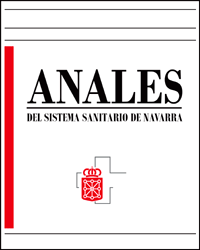NT-proBNP in chronic obstructive pulmonary disease patients
DOI:
https://doi.org/10.23938/ASSN.0162Keywords:
Enfermedad pulmonar obstructiva crónica (EPOC). Insuficiencia cardiaca. BNP.Abstract
Background. Brain natriuretic peptide (BNP) is produced and released mainly from ventricles. It has several physiological actions. BNP has been shown to be useful for diagnosis and prognosis in heart failure. The aim of this study is to analyse NT-proBNP levels in chronic obstructive pulmonary disease (COPD) patients and to distinguish factors which could modify these levels. Patients and methods. A descriptive and prospective study was made. COPD patients admitted due to acute exacerbation of this disease at the Hospital Universitario Lozano Blesa (Zaragoza, Spain) were included from November 1st 2004 to May 1st 2007. We included 99 patients; they had not suffered heart failure and they did not present any exclusion criteria. Blood samples were taken to determine NT-proBNP concentrations. Results. Mean age was 74 years and 79% of patients were men. Medium value of NT-proBNP was 1289 pg/ml. Mean body mass index (BMI) was 27.19. There were significant differences between NT-proBNP in patients with or without atrial fibrillation and depending on their age, but there were no differences between men and women nor between patients with or without renal insufficiency. Conclusion. COPD patients present high serum levels of NT-proBNP during acute exacerbations and these are modified with age and atrial fibrillation. NT-proBNP could be a prognostic factor identifying COPD patients at special risk, or with a worsening clinical evolution.Downloads
Downloads
Published
How to Cite
Issue
Section
License
La revista Anales del Sistema Sanitario de Navarra es publicada por el Departamento de Salud del Gobierno de Navarra (España), quien conserva los derechos patrimoniales (copyright ) sobre el artículo publicado y favorece y permite la difusión del mismo bajo licencia Creative Commons Reconocimiento-CompartirIgual 4.0 Internacional (CC BY-SA 4.0). Esta licencia permite copiar, usar, difundir, transmitir y exponer públicamente el artículo, siempre que siempre que se cite la autoría y la publicación inicial en Anales del Sistema Sanitario de Navarra, y se distinga la existencia de esta licencia de uso.








